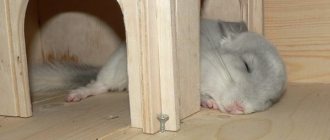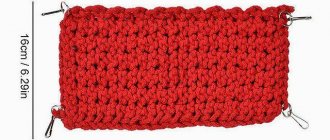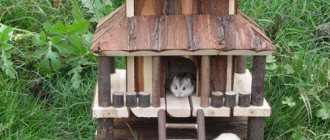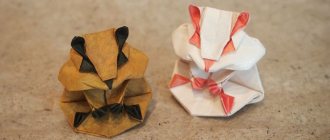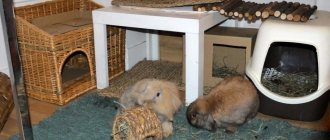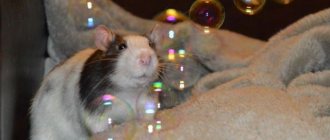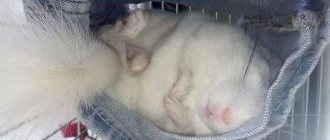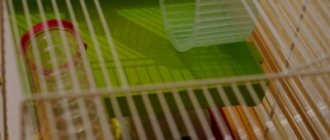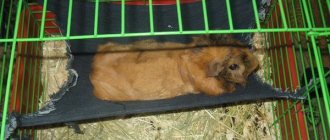Rats love houses and will use them for nesting, playing and sleeping. Hideouts mimic the burrows and nests rats live in in the wild and will give your pets a sense of security. Always provide at least one house per rat cage and try to provide many different types, especially if you have multiple rats.
Accessories for the cage
When caring, you need to think about the physical and mental health of your pets.
Rats are intellectually developed creatures. They need toys, hammocks to sleep in, places to wait out danger, and materials to sharpen their teeth. Toys and objects for incisors need to be changed frequently, otherwise your pets will get bored with them.
When choosing a wheel-style treadmill, make sure it is large enough for your rat, but does not take up too much space in the cage. Buying a cardio wheel is not a requirement. As rodents grow up, they lose interest in running on wheels.
Examples of homemade houses
Despite the huge assortment of pet stores, a lot of different designs and a large selection of materials used to make a house for rats, many breeders decide to make a shelter for their pet on their own.
This approach allows you to add all the necessary details into the design during manufacturing and make a house specifically for your pet, designed for installation specifically in your cage. Owners often build shelters from scrap materials:
- Cardboard house. The easiest and fastest option to implement is to simply cut out the necessary holes in a box of suitable size. It is short-lived, fortunately, new equipment does not require costs or a lot of time;
- House made from a plastic container. A worthy alternative to a house from a pet store, it is easy to clean and does not deteriorate as quickly as the previous option;
- House made from a flower pot. It is enough to simply file one side of the pot so that it can stand steadily at the bottom of the cage and put hay or paper inside - the rat will arrange its new home itself.
Rat house made from a plastic container
This material as a house for a rat is better than the previous one in that plastic does not absorb odors and is easy to wash. Consequently, it will not soon become unusable.
It is better to make a house for a rodent from a food container, since such plastic is quite hard and when the rat chews it, sharp edges will not form that can cause harm to the pet. Another important criterion when choosing plastic is its ability to protect the animal from sunlight. Rats love the dark, so the plastic for the house should not be transparent. In this case, it is absolutely not necessary to get rid of the bottom; make a hole of the required size and you can put the house in the cage.
Results
When the cage is small, this is not a reason not to give your pet a house. You can also attach it outside. They remove one of the doors, and attach the house to this place close to the wall. The second option is to hang a hammock. It takes up very little space.
When the rat is completely tame, the cage does not close; the house can simply be placed next to it. The important thing for a pet is that it has its own shelter.
Sources:
https://vplate.ru/krysa/dom/ https://petse.ru/gryizun/myish_krys/domik-dlya-krysy.html https://homjakam.ru/krysa/soderzhim/domik-dlya-krysy-svoimi -rukami
Methods for finishing finished pet houses
It’s not enough to make a house for a rat with your own hands, you also need to decorate your pet’s home. This technique will give the cell an unusual look. It will seem that the cage is a separate dwelling, a house within a house.
Photos of houses for rats, made by hand by some craftsmen, are stunning in their appearance. You can find entire castles, huts, and villas. This effect can be achieved through decorative design.
Read also: What weather awaits St. Petersburg residents in winter
The home can be painted, burned, or covered with thread or fabric. Attach rat toys to the walls or secure rings for them to run into.
An option for real needlewomen - a closed knitted hammock
Knitted houses for rats, created by yourself, are an option that will allow you to create colorful and comfortable housing for your pet. A knitted house is called a hammock. The hammock can be closed or open.
The principle of creating a closed hammock:
- The easiest way to create a design is with a hook. It is advisable to use acrylic threads for knitting.
- Knitting starts from the bottom. You can make the bottom double and put a piece of plywood in the resulting pocket.
- It is possible to knit in the round or knit individual parts and then sew them. The simplest option is circular knitting.
- It is worth casting on five air loops and closing them in a circle. Next, knit several rows adding 1 loop to each row. The number of such rows is determined by the desired size. This knitting will allow you to form the floor of the house.
- After making the bottom of the house, you can start knitting the walls. Rows are knitted without additions. Their number will determine the lifting height for the move.
- You need to count 10 loops and do not knit them until the opening is formed.
- Then the unknitted loops are closed using a chain of air loops.
- The roof is knitted in the same way as the floor. Only instead of adding loops in each row, a decrease is made.
In order not to think about how to shape the product using various frames, you can simply hang the hammock at several points. The house will stretch and take on the desired shape.
Hammocks for rats
Rats love hammocks! This is a great place to relax. There are many ways to make them yourself. Here are some simple ideas:
- Ordinary hammock.
Cut off one leg of old jeans (select the length based on the size of the cage), pass two ropes through it and tie the resulting hammock in a rat cage. You can use an old face towel or cut a piece of thick fabric to size, make a hole in each corner, thread string or string through it, and tie it to the bars of the cage. The hammock can be attached to the bars of the cage and using large pins or shower curtain hooks - this will allow you to quickly and easily remove the hammock for washing. - Hammock with pocket.
Cut a piece of thick fabric to the required dimensions. Fold it so that the top covers 3/4 of the bottom. Sew up the sides. Attach the hammock to the cage using ropes or hooks. Rats will be able to relax on the hammock on top or burrow into a pocket if they get cold. This hammock with a pocket is ideal in winter, especially if it is made of warm fleece. - Hammock.
Cut two identical pins from wood and insert them between the bars of the cage at the same level. You will end up with something that looks like a bird's perch. Cut a suitable size pant leg from old jeans (you can use other thick fabric) and sew along the edges. Now stretch the fabric over the wooden dowels. You should now have a hanging bunk. The fabric should not be too stretched, but should sag a little. - Attics.
Cut the leg of your old jeans to the required size. Thread two pieces of rope through the cut piece and tie them relatively close together to the bars of the cage, so that the pant leg piece is pulled up at the top and down at the bottom. You should end up with a triangle with the base at the top that your rats can crawl into. Alternatively, you can make four holes in the top of the denim leg and tie them to the bars of the cage with string. To create even more comfort for your pets, you can close the “loft” on one side. - Soft descent.
Cut a piece of thick fabric and tie it well to the high and low shelves. There should be a soft descent from floor to floor. Your rats will climb up it and smoothly slide down. It will be a good alternative to stairs or ramps. - Rat bag.
Cut a piece of thick fabric to the required dimensions. Fold it so that the top covers 3/4 of the bottom. Sew up the sides. It is better to make the upper part a little wider (trapezoid), so after sewing the sides, the resulting bag will always be slightly open. Attach the top two corners of the rat pouch to the cage using ropes or hooks. Rats will be able to climb into a hanging bag and rest quietly in it, hidden from prying eyes. - Cozy pouch.
Such products can be sewn from thick fabric or fleece, or you can simply use a small old bag. Place the finished bag on the floor of the cage and secure its upper edge with a hook or rope so that the entrance is always open. It is better to place such cozy bags under stairs and ramps. Your pets will love to sleep, play or fight inside them.
When you do, make two. A spare hammock will always come in handy when the first one is in the wash or gets torn to shreds.
Reviews
Anna Koteeva, 32 years old, Kropyvnytskyi
For our daughter’s fifth birthday, my husband and I decided to give her a gift – a degu. Since our apartment is not large, my husband decided to use the niche wisely, where they placed a house for the pet. We did not buy a ready-made cage, since they are not very cheap, and despite the fact that houses for hamsters or rats are not suitable for the Chilean squirrel. Therefore, the husband himself made a cage from plexiglass on one floor. Since we knew that such animals live in pairs, we gave the baby 2 degus. Imagine our surprise when a year later one “boy” brought us offspring. As a result, the husband had to finish 2 floors and another house, since it turns out that until the babies grow up, the males need to be kept separately. I would also like to add that such rodents need their own houses, that is, one housing per individual. Otherwise they fight.
Timofey Kolt, 51 years old, Uman
I work in a pet store and they often buy Chilean squirrels from me. When a buyer purchases an animal, he tries to buy everything necessary for it. Unfortunately, cages for such rodents are not very cheap, so many people simply buy furnishings for them, making the house themselves. And here not everyone doesn’t know that baby degus need their own corner. I make cells for sale myself, so I want to give one piece of advice. Since such animals do not like direct sun, they need a place where they can hide from it. If it is not possible to buy a ready-made house, then you can simply cover one of the corners with thick dark fabric.
Kristina Lebedeva, 24 years old, Moscow
My beloved gave me a degu on February 14th. We made the cage ourselves. I insisted on plexiglass, as it is easier to fit into the interior. I paid special attention to the comfort of pets. Therefore, having studied a lot of literature, I want to give a couple of tips. Degus secrete a lot of liquid, which is why we change the tray almost every day. Once every 3-4 months, my boyfriend makes me new wooden shelves, as they absorb moisture very strongly and begin to smell unpleasant. Also, so that my little ones wouldn’t get bored, I sewed a hammock myself and hung it on the “2nd floor”. When I first set up the cage, I bought ordinary rodent houses for them. Literally by the second month, they no longer resembled anything. So then I bought them a home made of pine needles. It turns out that this breed is absolutely safe for degus, but it tastes bitter, so they don’t touch the houses anymore.
What to equip
Rats are very energetic animals; structures for climbing and other active games must be placed in the house: ladders, shelves, tunnels. Unlike their other rodent brethren, they are indifferent to the spinning wheel and are not worth purchasing.
First of all, build a “nest”; an ordinary cardboard box with a drilled hole will do for its manufacture. In such a shelter, your tailed friend will feel comfortable and safe, relax and sleep. Place paper and small rags on the bottom; they will be used for home improvement. If you want to please your pet, buy a nest in the form of a ball, hanging basket or hammock; rats love them very much.
Why is it necessary to equip a cage house?
Among all the reasons why your pet rat needs a secluded place in his cage, there are five most common reasons why the animal needs a place to hide:
- Stressful situations. This can include fear. Any rat, even if it is tamed, can be frightened by loud noise, too sudden movements or a stranger. If the rat does not have a place where it can hide from the cause of stress, aggression on the part of the animal is possible. Also, due to stress, the rat may develop health problems;
- Draft. Rats are very sensitive to drafts, which is why they need a shelter with dense walls to protect themselves from drafts and reduce the risk of colds and other diseases associated with hypothermia;
- Cold. It is much easier to stay warm in an equipped shelter when the temperature in the room in which the cage is located is low. Rats always try to insulate their house with scraps of fabric and pieces of bedding; often several rats sleep in one house at once, so the temperature in the shelter is much higher than room temperature;
- Heat. Rats don't like it when the room is hot and stuffy. In order to avoid direct sunlight and overheating, the animals hide in their cool shelters;
- Health problems. In addition to climate-related reasons, an animal can instinctively hide in its shelter when feeling unwell or having health problems in order to feel safe.
The most urgent need for equipping a secluded place is felt by females, who are much more timid than calm males.
House for a rat: how to choose and make it yourself?
join the discussion
Share with your friends
Decorative rats have captured the hearts of many pet lovers. These are very smart, inquisitive animals with their own character and habits, and the owners try to make their maintenance as comfortable as possible. One of the conditions for this is that the animal has its own house. How to choose the right one or make it yourself – we’ll talk in our article.
What to do with a rat trap and a caught rat
Of course, a person is no longer a medieval barbarian, but in relation to a caught rat, there is only one solution - liquidation. This can be done as follows:
- add water to the container so that the animal drowns;
- a precise blow to the head with something like a bat;
- shoot the pest if you have a suitable weapon;
- if it is possible to transfer the animal into a sealed container, you can send the “criminal” to the gas chamber. Mix soda and vinegar in a cup, pour into a container, the animal will suffocate (this is considered a humane method of punishment).
The methods described seem terrible, but a person cannot, like the Pied Piper of Hamelin, control animals with a pipe, so there are simple methods of elimination.
How to make it yourself?
It is not necessary to purchase a ready-made hammock for your pet at a pet store. Store-bought products are not always of good quality and reasonable price. From available materials you can make a good and reliable model of the required size. During production, a number of recommendations should be taken into account.
- There is no need to try to save free space in the cage and make a bed that is too compact. It is better if the hammock is 2 or more times wider than a rodent.
- It is best to use metal objects, such as paper clips and chains, as fasteners for the product. Such fastenings will be more reliable than a simple rope, which a rat can easily chew through.
- The fabric from which the hammock will be made must not only be durable, but also safe from a toxic point of view. If it was painted with harmful dyes, then the pet may get poisoned. It is best to use natural types of fabrics rather than synthetics.
- Metal parts can only be used as fasteners, but not as the main canvas for the bed. A metal mesh is stronger than fabric; an animal is unlikely to chew through it and ruin it, but it can injure the pet. In addition, metal is too hard and cold material, so the rodent will be uncomfortable and uncomfortable on such a hammock.
From jeans
Using old denim clothes is one of the easiest ways to make a hammock for rats. In this case, you don’t even need to pick up a needle, thread and sew. All you need to make a hammock is:
- unnecessary jeans;
- stationery scissors;
- ruler or measuring tape;
- a small piece of old soap;
- metal chain or paper clips.
It will take no more than 10 minutes to make a denim bed. It is best to use old wide men's jeans. You need to measure 25 centimeters from the bottom edge of the trouser leg and mark the cut with a bar of soap. Then you need to cut a piece from the trouser leg and start making fasteners.
The number of staples in the chain will depend on the height at which you plan to hang the hammock. The materials used must be quite strong so that the fasteners can withstand the weight of the decorative rat. Chains or staples are threaded through one layer of jeans at the four corners of the cut piece. After this, you can place the bed in the cage and attach it to the metal bars. The rodent can be placed on the lounger either on top or inside the trouser leg itself.
Out of the hood
You can convert a hood from an unnecessary item into a hammock for a rodent. In this case, the process will take a little more time and effort than when making a denim couch. In addition to the hood itself, you should first prepare the following things:
- stationery scissors;
- sewing machine or regular needle and thread;
- large diameter metal wire that will serve as a frame.
If the hood was originally attached to a sweater or jacket with a zipper, then it must be cut off. To create a hole for the wire, the uneven edge must be bent 1-1.5 centimeters and stitched well. A metal wire is inserted into the hole, after which the edges need to be sewn up. A canopy hammock is usually made in the shape of a bag. To do this, the edges of the hood, which were located closer to the face, are sewn together. The finished product can be attached to the cage using sewn ties made of thick rope or on a chain of paper clips.
From a piece of fabric
To make a hammock, you can use a single piece of fabric. You can purchase it at the store or use old unnecessary things. For example, you can fold a pillowcase, sheet or towel several times and sew up the edges. If the material will be purchased in a store, it is best to buy fleece or cotton fabric. The size of the piece of fabric must be selected in accordance with the dimensions of the cage and the animal. As a standard, you can use a canvas of 30x60 centimeters. In addition to the hammock base, you will need the following things:
- needle and thick threads;
- stationery scissors;
- fittings (eyelet with washer) for edging holes;
- a hammer or special pliers and a hole punch for installing eyelets;
- hooks designed for shower curtains in the bathroom.
From the two narrowest sides of the rectangular piece you need to fold 1 centimeter of fabric and sew up the folds. The stitched ends need to be connected to each other in the center of a piece of fleece or other material. Next you need to sew the long edges. The resulting fabric must be turned inside out through the hole in the center.
You need to install eyelets in the four corners of the piece of fabric. Then hooks are inserted into the holes reinforced with fittings, after which the hammock can be hung in the rodent cage.
Step-by-step instructions for creating housing for an animal
At home, the easiest way to build a home for a rat is from:
- cardboard;
- wood or plywood;
- fabrics;
- plastic bottle.
Each option has its own advantages and disadvantages, you can choose the one that suits you most.
From cardboard
To create a cardboard house you will need the following materials:
- box for shoes, household appliances, etc.;
- scotch.
Did you know? According to a rough estimate, there are 2 times fewer people on our planet than rats.
How to make housing for a rodent:
- Use a pencil to mark the location of the entry holes.
- Using a knife, cut off the bottom of the box (so that the house does not get dirty so quickly) and make holes.
- Tape the exposed edges with tape.
This is one of the simplest and cheapest options available to everyone; it cannot harm the pet in any way. But about once a week you will need to make a new one, because it gets dirty and is easily chewed through. For work, prepare a pencil and a stationery knife or scissors.
Wooden house
To build a house you will need:
- wooden box for fruits or vegetables;
- Ponal wood glue.
Construction will take place using the following tools:
- pencil;
- paper;
- brush;
- hammer and nails if you decide not to use glue;
- sandpaper;
- jigsaw;
- wood hacksaw.
We recommend finding out whether you can give your pet rats cheese and other dairy products.
The creation procedure looks like this:
- Draw a drawing of the product on paper
- Cut out the parts and holes for entering them. Pour boiling water over it to disinfect.
- Use sandpaper to sand down any rough spots.
- Glue the parts together, there will be no bottom. This glue is non-toxic. If you want to use nails, make sure that the animal cannot injure itself on the sharp edges.
- To such a house you can build a low staircase from a board 7–10 cm wide with bars glued across it in the form of steps.
Chemicals contained in building materials can cause serious harm to a rat's health.
The box can be replaced with other boards that do not have impregnation, varnish, or paint. You can use fruit trees, rowan, oak, birch, linden. Other types may contain materials that are toxic to rodents. Such a house is durable and helps the animal wear down its teeth, but it must be thoroughly washed from time to time and replaced with a new one.
We recommend finding out how long rats live at home.
Instead of construction boards, you can take plywood, which should be kept in the oven for a while at a temperature of +100°C. There is no need to sand it with sandpaper; such a house will last a long time. However, plywood may contain glue, which, if ingested by a rat, will cause poisoning.
Soft fabric house
To sew a soft house you need materials:
- dense fabric for the middle layer - approximately 1 m;
- pattern paper;
- pleasant-to-touch fabric made from natural fibers for the inner layer - approximately 1 m;
- threads;
- metal rings - 5 pcs.;
- carabiners for attaching to the cage - 5 pcs.;
- thin fabric of beautiful colors for the outer layer - approximately 1 m.
The strength of your home will be ensured by the following tools:
- pencil;
- fabric chalk;
- pins;
- needles;
- tailor's scissors;
- sewing machine.
Did you know? On Earth, rats live longer than humans by 48 million years.
Sewing technology:
- Measure the width and length of the cell, write down the results, subtract 2 cm from them, draw a rectangle according to the obtained dimensions. There will be 2 such parts, these are the lower and upper canvas. Approximate size: 22 x 45 cm.
- Subtract 1 cm from the width of the house from the previous point (in the sample - 22 cm), and set the other side aside, depending on the size of the rat, 12–15 cm. You need 2 such parts, these are the side walls. Approximate size 21 × 12 cm.
- Subtract 2 cm from the length of the house from point 1 (in the sample - 45 cm), the other side should be equal to the height of the house from the previous point. This part is required 1, this is the back wall. Approximate size 12 × 43 cm.
- For an entrance, a rat requires a width of 8-9 cm, it is better to make at least 2 of them. For this purpose, divide the front wall into several parts (for 2 entrances you need 3 parts). One side will be equal to the height of the house (in the sample - 12 cm). To calculate another, subtract the dimensions of the inlet holes from the length of the part from step 3 and divide by the number of parts. For example: (43 – 2 × 9) / 3 = 8 cm. That is, the size of the part is 12 × 8 cm, there will be 3 pieces.
- Draw the resulting rectangles on paper, cut them out, and label them so as not to confuse them.
- If you have chosen new fabric for sewing, run it over with hot and cold tap water, dry it, and iron it. This way there is a greater chance that it will not shrink after washing.
- Pin paper patterns onto thick fabric for the middle layer (raincoat, tarpaulin, double-thread, trim), trace with chalk without seam allowances, and cut out.
- Attach the drawings to the material for the inner layer (cotton flannel, fleece) in the same way and cut them out.
- Lay the paper parts on the fabric for the top layer (chintz, calico, colored flannel), outline with chalk, make seam allowances of 1.5–2 cm on all sides, cut out.
- Place the outer elements with the wrong side up, the sealing elements on each, placing them along the drawn lines, then the inner ones with the front side facing you. Pin it with pins. As a result, the 2 top layers should coincide, and the edges of the bottom should protrude at the same distance around the perimeter.
- Fold the corners of the front parts towards the inner ones. Secure.
- Place the edges of the outer elements on top of the lower ones, forming corners at 45° on each side. Make a baste with a needle and thread of a contrasting color by hand. Remove the pins.
- Set your sewing machine to a zigzag stitch type and sew along the edge of the facing fabric. Take the thread to match it. Start sewing from the corner, stepping back 1-2 mm from the edge. When you reach the edge of the facing fabric, without removing the needle, lift the presser foot, turn the piece 45° in the direction you will continue sewing, and press. Go along the edge to the corner, leaving the needle in the fabric, lift the presser foot, turn the piece to sew the corner, sew a seam. Then rotate 180° (needle down, presser foot up). Sew a few stitches back to where the edge of the next side is. Proceeding in the same way, turn the part, sew a seam to the corner, repeat around the perimeter. In this way you need to flash all the elements. Remove the basting.
- Fold the parts of the bottom fabric and the back wall together, wrong side to side, along the long edge, leaving 1 cm on both sides, pin, baste by hand, then sew on a machine with a straight line with a small stitch, passing along the edges twice. Remove the basting.
- Place the side wall piece on the short side of the bottom fabric with the wrong sides facing each other, align the edges, pin, sew by hand, stitch like the back wall. Remove the basting.
- Repeat for the other side wall.
- Stepping back 1 cm from the side edge, place 1 of the parts of the front wall on the bottom fabric with the wrong side facing each other, pin it together, baste it, and machine stitch it like the previous ones. Unravel the basting.
- Repeat from the opposite edge for the other front wall piece.
- Sew its last element in the center in the same way. In the corners and in the center of the top sheet, using small strips of fabric, tightly sew metal rings, by which the house will be suspended.
- Align its long edge with the back wall with the wrong side facing each other, retreating 1 cm from both sides, pin it with pins, baste, stitch, not forgetting to secure and remove the basting.
- Proceeding as on the bottom element, sew first 1, then the other side piece, the outer and central parts of the front wall.
- Do not make side seams; perhaps the gaps will force the rat to give up the desire to gnaw at the home. The ends of all threads must be secured and cut off.
Such a home will be environmentally friendly and safe, but it must be washed often, as the fabric absorbs odors. In addition, it can quickly lose its appearance if an animal decides to gnaw a hole in it.
From a plastic bottle
In order to build a house from plastic bottles, the following materials are required:
- plastic bottle with a volume of at least 5 liters;
- tape or tape;
- sleeve from an old jacket.
And also tools:
- marker for marking;
- stationery knife.
Important! If the house is made too long, it will sag.
To build a home:
- Divide the bottle into 3 equal parts.
- Using a knife, cut out the center part.
- Place the top piece over the bottom piece.
- Secure with tape or tape.
- Use a knife to cut an opening on one side.
- Connect the wide edge of the sleeve with the hole with tape or tape, gluing it from the inside and outside. This will give the rat a chance to hide. You can simply paste over the sharp edges of the opening.
The advantages of such a building include:
- the walls do not absorb odor;
- it is easy to clean.
Did you know? According to one version, dinosaurs became extinct because rats ate their eggs and thereby deprived them of their offspring.
Its disadvantage is that when the animal gnaws a hole, it can cut itself on the sharp edges. A small piece can get into internal organs and injure them. In addition, it will be stuffy inside, especially in summer.
Interesting ideas for houses made from scrap materials
If you don’t have a lot of time or special desire to make a home for your pet, then you can use improvised devices. The process will take a few minutes, and you may only need a utility knife to make it.
You can make a house for a rat with your own hands using improvised tools in a few minutes like this:
- A plastic food tray will make a wonderful house; just cut out a passage and several windows in the walls of the dish;
- if you have the remains of Lego at home, then in a few minutes you can build a comfortable “villa” for your pet;
- an old parcel box is a simple and environmentally friendly option for building a home;
- a clay pot or an old cup laid on its side is an original option that will appeal to the rodent and the person who will clean the house.
Depending on the shape and size, it is easy to select other options for construction: a chandelier shade, a vase, a teapot, a small teapot, and so on.
The easiest way to create a home for a rat
No matter how paradoxical it may be, the easiest way to make a house is using the papier-mâché technique. The design can have any shape, size, color. The set of materials and tools is minimal: a mold for the product, a roll of toilet paper or a pack of napkins, water, a brush and a little time.
How to make a house for a rat with your own hands using the papier-mâché technique?
- Install the prepared form.
- Tear napkins or toilet paper into thin strips.
- Lightly moisten the strips of paper in water and place them on the prepared form.
- You need to make sure that the shape is not visible through the paper, and that the cellulose layer is sufficient to hold the shape.
The paper will dry within 24 hours. Then you should carefully remove the form, you will get a wonderful house. You can use a utility knife to cut holes for windows and entrances. If desired, you can paint your home with safe paints.
What is it needed for
Does a rat really need a house? Experts insist that the animal must have its own secluded corner. Let's try to figure out the reasons.
First of all, it is necessary to note the stressful situations that can happen to an animal due to many factors. A stranger, loud noises, sudden movements - all this can frighten the animal, and it will want to hide.
In the absence of such an opportunity, even tame rats can experience attacks of aggression and panic, which in severe cases lead to health problems.
While providing comfortable conditions for a pet, owners need to take care that the cage is not exposed to drafts. Rats can be very sensitive to them and often get colds. A house with windproof walls will allow you to hide inside and not get sick. Also, in an insulated house you can easily hide from the cold, even in an apartment where, for some reason, the temperature is quite low. If direct sunlight hits the cage, rats, on the contrary, can hide in a shelter from the heat.
The rat feels safe in the shelter . This is especially important if the animal is not feeling well. Calmer males feel much more comfortable without a house, while girls, on the contrary, need protection and a secluded corner.
House for a rat made of wood
Wood is the best material for a rodent's house. There are several reasons for this. The first reason is that the material is environmentally friendly, the second reason is that it does not harm the pet when it sharpens its teeth.
However, there are also disadvantages. The main disadvantage is that wood easily absorbs moisture (rat feces), begins to smell bad and becomes completely unhygienic. Such a house should be thoroughly washed periodically, and over time it will have to be completely replaced with a new one.
Creating a wooden house is a creative process and you can make it of any shape and type. But do not forget that not any wood is suitable for a rodent. Some tree varieties are not only unhealthy, but also toxic. Wood from fruit tree varieties is best suited:
- pear,
- Apple tree,
- Rowan,
and wild ones are also suitable:
- Linden,
- birch,
- oak, etc.
Secrets of experienced house makers
Before making a house for a rat, it is worth considering several features of certain parameters:
- the height of the structure should be such that the rat cannot reach the ceiling while standing on its hind legs;
- the width and length of the room are made such that the rat can freely fit in a lying position;
- The entrance should be wide, but not too wide, the pet should pass through unhindered, and the person should be able to easily clean inside.
Other recommendations may relate to the type of material (we mentioned this above). As you can see, making a home for a small rodent with your own hands is not only easy, but also interesting.
Why do rats use shelter?
Tame domestic rats may use the cage house quite rarely, but this does not mean that they do not need it. All pets need shelter at certain times.
Stress
Even very tame rats are frightened by unfamiliar people, changes in their usual routine, and loud noises. Without a place to hide, your pet will develop stress, which can lead to aggression.
Bad mood, malaise
If an animal feels unwell, it feels an instinctive need to hide, to make sure that it is reliably protected.
Cold
It is much easier to stay warm in a shelter, especially if several animals sleep there at once. Most rats love to insulate their burrow by actively dragging pieces of paper and fabric into it.
A shaded house for a rat will help the animal endure too warm summer days and stuffiness, and protect it from the sun's rays.
Drafts
Small rodents catch colds very easily; a shelter with dense walls will provide additional protection and help reduce the risk of disease.
IMPORTANT: Females, who are shyer and more restless than males, are especially in dire need of shelter.
If this is a rat with a distrustful character, the lack of opportunity to hide will inevitably affect its behavior - aggression, depression may appear, and the animal will not make contact.
Distinctive features of degus
The Chilean squirrel is small in size, but has a long tail. The body is covered with thick fur of brown color with a yellowish tint. There are lighter colored animals. Their fur is greyish and silvery. The natural color is called agouti: the hair near the body is light, it darkens towards the tip. Home breeders have bred colored degus of various colors: cognac, blue, spotted, gray. Some have a color similar to a Siamese cat. Agouti-colored individuals are found in the wild. Rodents are small, but larger than mice and dormouse. To choose the right cage for degu squirrels, you need to know how many centimeters the length of its body is:
- in an adult common degu, the body length can reach 22 cm. Larger Chilean squirrels have been found in nature. Their body length was 40 cm, but this is considered rare. The animal is active during the day. At night, rodents climb into holes. Squirrels live in families. It includes 1-2 males, 3-4 females and offspring. The leader is the largest degu;
- Bridges' degus are not as large as individuals of the common species. Their body length is 9 cm. Animals prefer rocky terrain and beech forests. They don't build burrows. In times of danger, they hide under stones and tree roots. Squirrels climb trees well and move quickly along steep cliffs. Bridges' degus are nocturnal;
- Moon-toothed degus are small rodents. Its body length is 12 cm. The animal prefers mountains. Animals can be found at an altitude of 5 thousand m above sea level. They tolerate large temperature changes well. During the day, animals are inactive. These are nocturnal squirrels. They have well-developed night vision;
- The body length of the dormouse degu is up to 18 cm. The animals are nocturnal. They spend the day in burrows, but the tunnels are not as complex as those of the common species. Rodents live under cacti and under the roots of acacias. Some animal species are common in mountain ranges. Here they do not dig underground shelters for themselves. They nest in rock crevices;
- The Pacific degu prefers a humid climate. He lives on the ocean coast. Its limbs are adapted for digging holes and climbing trees. The animal grows up to 20 cm.
All Chilean squirrels have the same tail length, 10-12 cm. It is evenly covered with bristles. Towards the end the hairs become longer. They form a fluffy brush. Its length is about 6 cm. The animal raises its tail: it is slightly rounded towards the back. You always want to touch the tassel on the tail, but you shouldn’t do this. The squirrel sheds the skin on its tail and runs away. In this way she escapes from danger. The animal gnaws off the exposed part of the tail. The wound heals quickly and the tail no longer grows back.
The body weight of the Chilean squirrel is from 130 to 300 g. The weight of newborn puppies is no more than 14 g, but they grow quickly. In the first 2 weeks, they add up to 3 g. Subsequently, up to week 6, their weight increases by 15 g per day. Puppies show their greatest growth at the age of 4-8 weeks. Weight gain per day can reach 24 g. At 8 months, the weight of the female reaches 220 g, the male 300 g. Individuals enter the puberty phase. Crossbreeding can be done at 12 months.
All degus have a very well developed sense of smell. They remember smells and hold them in their heads for a long time. Their acute sense of smell helps them hide from danger. If a domestic rodent is offended by one of the family members, a cat or a dog, then it will remember the smell of its offender and will always show aggression towards him.
Why do rats need shelter?
A trained pet uses the house infrequently. But the shelter should still be in the cage so that the rat can use it at the right time.
Stressful situation
Tame rats are also afraid of strangers and loud noises. They may experience stress when the cage is moved to another location or a new pet appears in the apartment. If the animal does not have the opportunity to hide in order to calm down, it will be nervous and aggressive.
Females often need shelter. By nature they are more restless and timid than males.
Bad feeling
Rodents may feel unwell for no particular reason. For example, when you ate something inappropriate. At such moments, they need to retire to get into the right physical shape. The animal may have a desire to hide when it is offended. Rats with a distrustful nature often hide. They need it physically and psychologically, otherwise they will feel bad.
Need to keep warm
It must be taken into account that rats do not like cold and do not tolerate heat well. In a small shelter it is easier for animals to warm up if they are frozen. Sometimes rats deliberately insulate their house for these purposes.
It helps out in cases where there are many animals in the cage. In a small shelter the whole company becomes cozy and warm. Structures made of wood and cardboard are considered the warmest.
Hide from the heat
Ceramic and wooden shelters are especially good for pets in the hot summer. To do this, it must be shaded. It will play the role of a canopy when direct sunlight penetrates the cage.
In case of draft
It may happen that with the doors and windows open, a draft will begin to move around the room. Rodents catch cold easily in such cases. Feeling discomfort from the blowing wind, the rat will quickly hide from it behind thick walls.
General design requirements
The Chilean squirrel loves space, so its home should be spacious. Animals are very active, constantly on the move. Animals will not be able to show their activity within 4 walls, so they increase the area by adding shelves.
It is recommended to choose a multi-tiered cage with 2-4 shelves. To make cleaning easier, a tray is provided. What are the basic cage requirements for a degu squirrel:
optimal size for a pair of rodents: length 1.2 m, width 0.6 m, height 1 m. For a larger number of animals, a more spacious cage is needed; Plastic and wooden parts should be avoided. The material is easily susceptible to degu teeth. Plastic, fiberboard or MDF are harmful to the health of any animal; the cage should be made of metal mesh. The optimal distance between the rods is 1 cm. If the cage contains a female with puppies, then the distance is reduced to 0.5 cm; the rods must be strong. A degu squirrel can easily cope with a mesh made of thin twigs; Chilean squirrels live in burrows. They love to dig. This is inherent in them by nature. In order for them to successfully realize their instinct, it is necessary to choose a durable pallet. It is made of aluminum sheet and plexiglass. It is possible to adapt a plastic box, but all protruding parts must be covered with aluminum tape
The rodent will not be able to grasp a smooth surface; You also need to pay attention to the door lock. A degu will learn to open a simple latch
Animals are very smart and learn quickly. It is recommended to use a carabiner as a lock.
For degus, do not choose a cage for guinea pigs, for rabbits or for chinchillas. Animals are larger than squirrels: they have a larger spacing between bars. The structures are low. Squirrels will not be able to actively run in them. Bird cages are tall, but they won't work either.
They are not wide enough or deep enough. For degus, buy a special cage in the store, make it to order, or build a home for rodents yourself. If indoor space allows, it is better to purchase a display case for degu.
To choose the optimal cell size, adhere to the following indicators. They were compiled by zoologists. At the same time, all useful areas for degus were calculated: floor, shelves, house:
- in a structure with an area of 12,000 - 14,000 cm2, only 2 rodents can be located;
- a structure with an area of 15,000 - 18,000 cm2 is intended for 3 animals;
- 19,000 – 22,000 cm2 – 4 whites;
- 23,000 – 26,000 cm2 – 5 degus;
- 27,000 cm2 – 6 rodents.
The usable area is calculated as follows:
- if the floor length is 1 m, width is 0.5 m, then the area will be 5,000 cm2.
- the cage has a shelf 60 cm long. It is located on the side wall. Its area is 3,000 cm2;
- if the usable area is 8,000 cm2, then this is not enough even for one squirrel. Increase it by installing a new level or shelf;
- a level 1 m long and 50 cm wide gives an area of 5,000 cm2. A hole is made in this panel for the passage of animals, and it is equipped with a ladder;
- The useful area in a two-tier structure with 1 shelf will be 13,000 cm2. A pair of degus can live in such a dwelling.
These calculations must be taken into account when building cells with your own hands. Experts point out some more parameters that must be observed:
- the height of the cage should not exceed 1.2 m for 2 squirrels;
- the distance between tiers or shelves is maintained no more than 35 cm;
- for adults, the distance is increased to 50 cm.
The dimensions of structures for squirrels that are displayed in stores do not always correspond to the standards, so degus breeders often assemble corners for their pets themselves.
Features of making fabric with your own hands
The hammock will get dirty during use, so it must be washed regularly. Sometimes a rat begins to chew the cradle or use it as a toilet, which reduces the service life of the product, so after certain intervals the old hammock will have to be thrown away and replaced with a new one. In order to save money, it is better to sew a new cradle yourself, since the necessary materials and accessories will cost much less than a ready-made store product.
Did you know? In a year, an adult rat eats about 12 kg of food. Strong teeth allow these animals to gnaw through even such strong materials as iron and concrete.
Selection of material and necessary tools
A rat hammock can be made from any soft fabric you have on hand. The material often used is old jeans, unwanted bed linen or terry towels. Patterns of appropriate sizes and shapes are made from the selected fabric, and then sewn together by hand or using a sewing machine.
In addition to fabric, to make your own cradle you will need the following tools and materials:
- scissors;
- ruler;
- round pattern;
- sewing pins;
- needle and thread;
- a piece of chalk;
- pieces of tape (for tying to the roof of the cage).
Step-by-step instruction
To sew a simple and beautiful hammock for your pet rat yourself, you don’t need any special knowledge. Just take a few colorful pieces of soft fabric and spend a little time creating a cozy cradle for your pet.
Find out also what to feed and how to care for a decorative rat.
Step-by-step instructions:
- Prepare two pieces of fabric. Stack them on top of each other, straightening out all the folds on a flat surface.
- Using a ruler and chalk, mark the desired dimensions of the square hammock on the top flap.
- Insert sewing pins into the corners of the intended square to secure the top and bottom layers of fabric together.
- Cut out a square along the marked boundaries. Using a template, draw identical arcs on each side so that they do not reach the corners of the cut out figure.
- Cut the fabric along the marked arcs. Remove the pins connecting the top and bottom flaps.
- Prepare 4 ribbons approximately 30 cm long. Fold them in half and then secure them between pieces of fabric (two ribbons on two opposite sides of the figure), leaving the ends free.
- Sew the edges of the top and bottom flaps. Tie the resulting product to the walls and roof of the cage using the free ends of the tapes.


